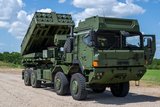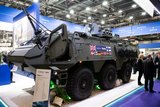First APMI round fired from Stryker
The first Accelerated Precision Mortar Initiative (APMI) round fired from a Stryker vehicle in Afghanistan accomplished a direct hit on a target with the first round fired, the US Army has revealed.
First fielded to dismounted troops in Afghanistan last April, the Program Executive Office for Ammunition is now fielding the 120 mm precision rounds to Stryker Brigade Combat Teams, according to a 16 July statement.
The army said that while APMI will not replace standard 120 mm mortars, its accuracy will allow a commander the ability to defeat a target with precision if there is danger of collateral damage.
APMI will be fired from the army's new Stryker Double-V Hull Mortar Carrier Vehicle (MCVV), which is used to provide high-angle mortar fire to support operations in complex terrain and urban environments. It now can fire APMI precision-guided mortars as well as conventional 120mm rounds.
‘Integration of APMI into the Stryker platform gives the troops greater flexibility and increased manoeuvrability,’ said Ted Hom, APMI product director.
Hom said that when fired from Stryker, APMI will ‘have the same precision, but on a platform that can easily go wherever needed’.
The APMI cartridge has a requirement of 10 meters circular error probable (CEP) and APMI combat rounds fired in Afghanistan are exceeding that requirement, Hom said.
The first Stryker MCVV combined training and live-fire exercise was conducted this June with an infantry division of the 3-2 Stryker Brigade Combat Team, higher headquarters 5-20 Infantry and B Troop 1-14 Cavalry, who are currently supporting an Airborne Brigade Combat Team in Afghanistan.
‘The biggest thing for us is that this is the first time manoeuvre commanders will have an incredibly accurate munition that is perfect for the targets we see in our area of operation, such as IED emplacers, historic Taliban fighting positions, and enemies close to troops in the open,’ stated Lt Eric Birdsley.
‘Our responsiveness to threats is greatly increased because commanders can approve the use of this capability,’ Birdsley added. ‘Also, due to the small battle space in our area of operation, the ability to shoot APMI at closer ranges than the Excalibur gives us a close-range precision capability we did not previously have.’
The research, development and integration of APMI onto Stryker is a collaboration of PEO Ammunition, the Armament Research, Development and Engineering Center, Joint Munitions Command and Project Manager Stryker Brigade Combat Team.
More from Land Warfare
-
![Lithuanian 1st Division to achieve initial operating capability in 2026]()
Lithuanian 1st Division to achieve initial operating capability in 2026
Lithuania is one of the countries stepping up its defences in the face of the war in Ukraine with a particular focus on its neighbour and Russian ally Belarus, which has been making incursions into Lithuania’s airspace with balloons and drones.
-
Medium knocked out of British Army LMP, with CAVS as heavyweight champion
As the British Army seeks to modernise and consolidate its diverse vehicle fleet, yet another change in direction is underway.
-
![Energy evolution: How laser defence systems are powering the next phase of air defence (podcast)]()
Energy evolution: How laser defence systems are powering the next phase of air defence (podcast)
Laser-based air defence is moving from promise to deployment as global threats evolve. In this special podcast, we explore how high-energy laser systems are reshaping interception strategies.
























